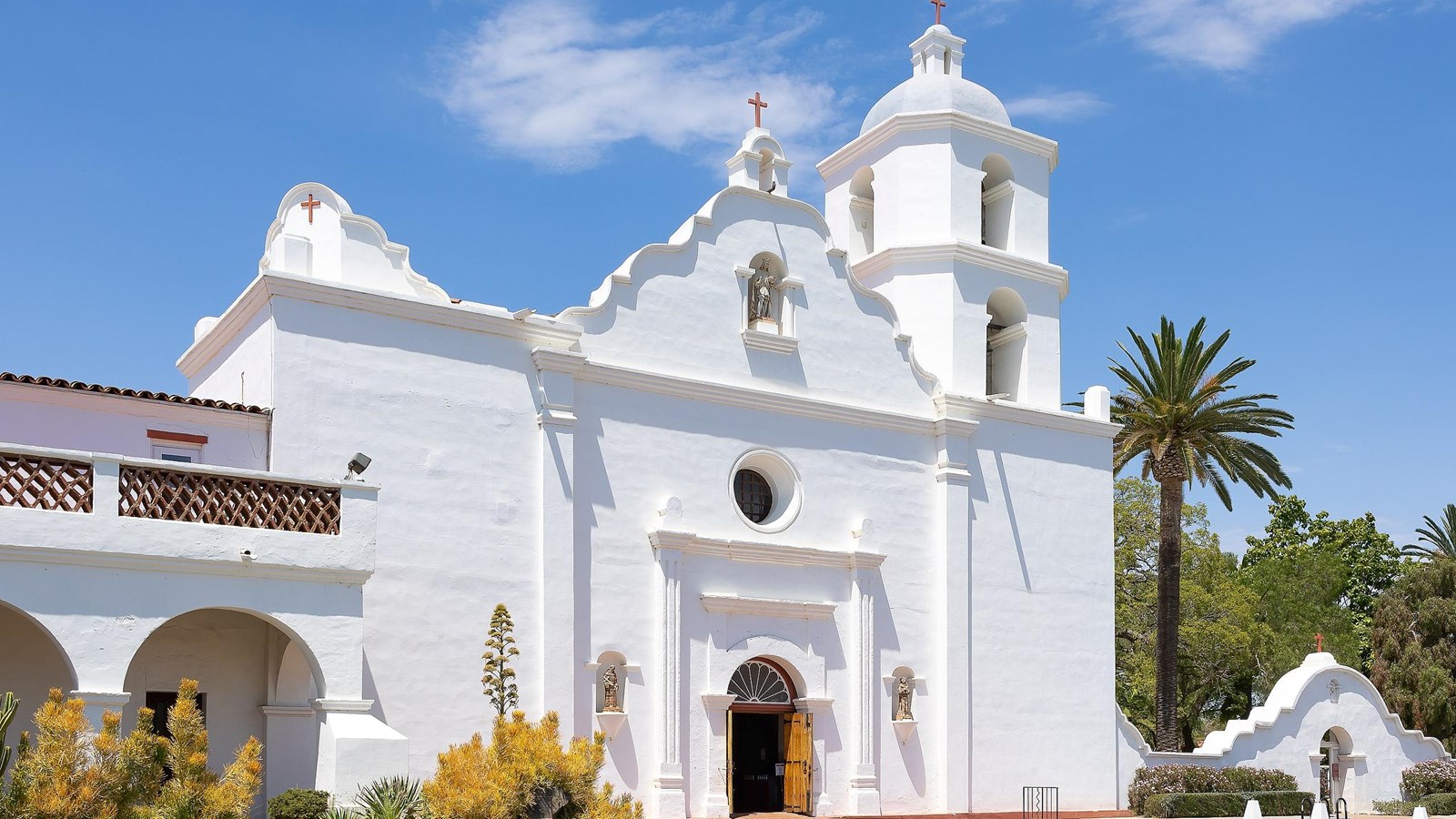Last updated: February 14, 2024
Place
San Luis Rey Mission Church, Oceanside, California

Photo curtesy of Frank Schulenburg, wikimedia commons
The San Luis Rey Mission Church, the eighteenth of the twenty-one original missions established by Spain throughout California. The building is one of only two cross-shaped churches built by the Spanish in the region. Founded in 1798, San Luis Rey de Francia Mission is in the sheltered valley just east of Oceanside. Erected between 1811 and 1815, the present church is the third one constructed at the site. At the time of its completion, the church was the largest building in Northern California. San Luis Rey is known today as the king of all the California missions. The history of the San Luis Rey de Francia Mission spans the early Spanish colonial period, the Mexican era, and the beginnings of California’s statehood. Today the church stands as a National Historic Landmark recognized for its significant contribution to the Spanish and Mexican heritage of the western United States.
The mission site contains other remains of the mission in addition to the church. All are set around and within a historic six-acre central square. Highlights include a sunken garden, elaborate lavanderia (open-air laundry), stabilized ruins of former mission buildings, and California’s first documented pepper tree. By the late 1700s, the Spanish government in New Spain (modern-day Mexico) had already authorized the establishment of seventeen Catholic missions throughout Alta California. The vast northern territory was lush with appealing resources for the Spanish, as well as a long coastline dotted with protected bays. The systematic establishment of missions was an inexpensive and strategic move to help bring religious and political beliefs to the Native Americans who populated the area.
Padre Fermín de Francisco Lasuén de Arasqueta founded the 18th of the Spanish missions, San Luis Rey de Francia, in 1798. He chose the original site, just east of modern-day Oceanside, for its protected valley, the availability of building resources and water, and the proximity of Indigenous people. Constructed in 1798 at the mission’s first founding, the original church was a small and simple adobe building like the majority of Spanish missions. By 1802, early success and an increase in Catholic conversions necessitated the building of a bigger church with adobe walls and a tiled roof.
The third church, the one that remains on the site today, dates from the peak of the mission’s activities. Construction on this church began in 1811, but it was not finished until four years later in 1815. Antonio Ramirez, a master stonemason, oversaw the work of Indigenous workers who performed the majority of the manual labor. The main walls of the new church were impressive: thirty feet high and five feet thick with an adobe interior and baked brick exterior. White lime plaster coated the walls, and the huge church must have gleamed in the bright California sun. The main façade of the church features a mix of Baroque and Classical styles including a seventy-five-foot-tall bell tower at its eastern corner. A western, symmetrical tower was originally in the plans but never constructed. The tower rang a chorus of eight different bells in the 1800s, but only four hang in its belfry today. Both the original floor and roof of the mission church were of terra cotta tile, and by 1829, a wooden dome sat atop the building. The octagonal dome had an eight-windowed lantern that filtered light down into the nave and crossing below. The restored dome remains today and is unique among California’s Spanish missions.
By the mid-19th century, the San Luis Rey de Francia Mission had expansive landholdings covering approximately 950,400 acres. Over 3,000 Indigenous people lived at the mission and tended the land and cared for the 50,000 head of livestock. Grapes, oranges, olives, wheat, and corn were just some of the crops produced on the property. The main mission buildings, including the church, ringed a large central plaza, 500-feet square. At the height of its operation, the mission included irrigation channels and an outdoor lavanderia (laundry), a convento for housing the friars, officers barracks, dormitories for residents, workshops of various types, a long decorative colonnade, and an extensive gated cemetery.
Mexico gained its independence in 1821 cutting short the period of prosperity for San Luis Rey Mission. Under a new Mexican law, all of the California missions were secularized within a decade. Many, including San Luis Rey de Francia, went through periods of divided ownership and neglect. As nearby pueblos grew, much of the quality materials of the mission church were stripped to use in new construction. Between 1847 and 1857, the mission church served as an operational base for the United States military. California became the thirty first State in the Union in 1850. The men stationed there were not greatly concerned with the upkeep of the church, even housing livestock within its walls. President Lincoln officially returned the mission to the Catholic Church in the 1860s, but the entire property was in such disrepair that the church abandoned it.
Mission San Luis Rey de Francia might have completely vanished from the landscape had it not been for a group of Mexican Franciscans who reoccupied the church in 1892. Under the guidance of Father Joseph Jeremias O’Keefe, a massive rebuilding and restoration began. Despite the deterioration over the years, much of the original mission remained, as did original drawings, plans and designs. After O’Keefe’s death, the restoration of the site continued.Today, San Luis Rey Mission Church is a part of the restored mission complex that sits on 56 acres of its original land.
